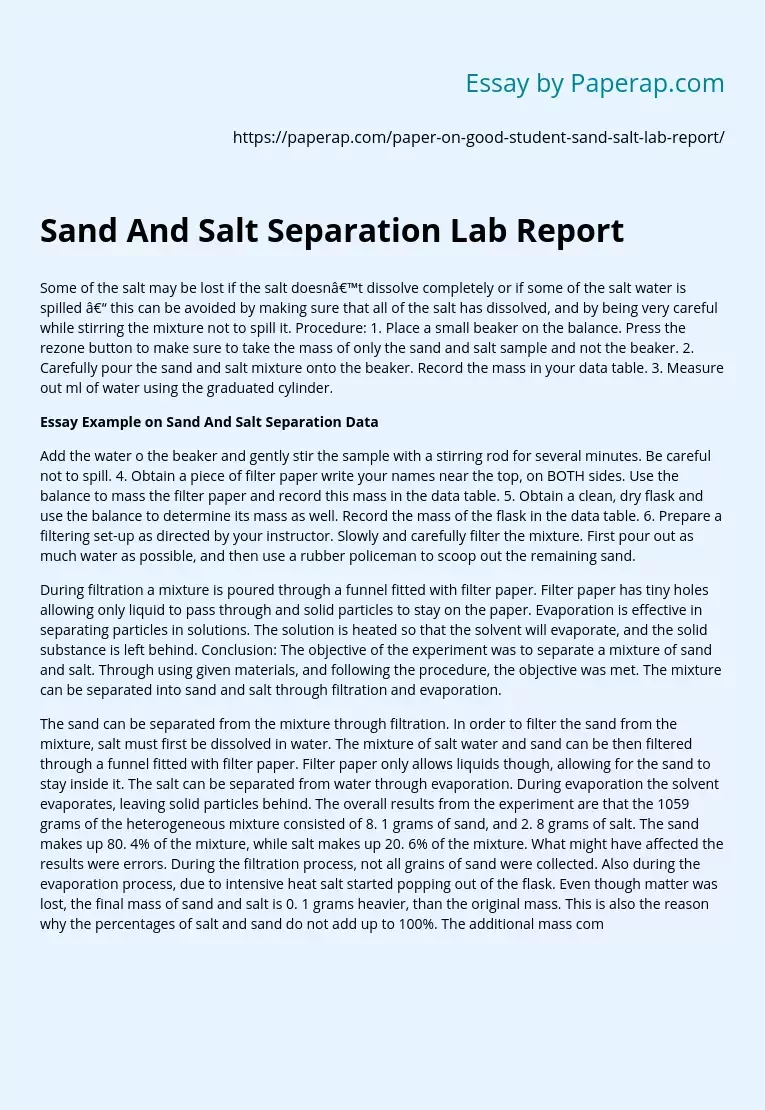Sand And Salt Separation Lab Report
Some of the salt may be lost if the salt doesn’t dissolve completely or if some of the salt water is spilled – this can be avoided by making sure that all of the salt has dissolved, and by being very careful while stirring the mixture not to spill it. Procedure: 1. Place a small beaker on the balance. Press the rezone button to make sure to take the mass of only the sand and salt sample and not the beaker. 2. Carefully pour the sand and salt mixture onto the beaker.
Record the mass in your data table. 3. Measure out ml of water using the graduated cylinder.
Essay Example on Sand And Salt Separation Data
Add the water o the beaker and gently stir the sample with a stirring rod for several minutes. Be careful not to spill. 4. Obtain a piece of filter paper write your names near the top, on BOTH sides. Use the balance to mass the filter paper and record this mass in the data table.
5. Obtain a clean, dry flask and use the balance to determine its mass as well. Record the mass of the flask in the data table. 6. Prepare a filtering set-up as directed by your instructor. Slowly and carefully filter the mixture. First pour out as much water as possible, and then use a rubber policeman to scoop out the remaining sand.
During filtration a mixture is poured through a funnel fitted with filter paper. Filter paper has tiny holes allowing only liquid to pass through and solid particles to stay on the paper.
Evaporation is effective in separating particles in solutions. The solution is heated so that the solvent will evaporate, and the solid substance is left behind. Conclusion: The objective of the experiment was to separate a mixture of sand and salt. Through using given materials, and following the procedure, the objective was met. The mixture can be separated into sand and salt through filtration and evaporation.
The sand can be separated from the mixture through filtration. In order to filter the sand from the mixture, salt must first be dissolved in water. The mixture of salt water and sand can be then filtered through a funnel fitted with filter paper. Filter paper only allows liquids though, allowing for the sand to stay inside it. The salt can be separated from water through evaporation. During evaporation the solvent evaporates, leaving solid particles behind. The overall results from the experiment are that the 1059 grams of the heterogeneous mixture consisted of 8. 1 grams of sand, and 2. 8 grams of salt. The sand makes up 80. 4% of the mixture, while salt makes up 20. 6% of the mixture. What might have affected the results were errors. During the filtration process, not all grains of sand were collected. Also during the evaporation process, due to intensive heat salt started popping out of the flask. Even though matter was lost, the final mass of sand and salt is 0. 1 grams heavier, than the original mass. This is also the reason why the percentages of salt and sand do not add up to 100%. The additional mass comes from an error in the separation recesses.
The water that was used to separate salt and sand could remain in the samples either from inadequate time period for the sand to dry, or evaporating. This could have been prevented through providing a longer amount of time for the sand to dry, as well as for the boiling of the solution. It would also be helpful to place the separated particles in hot oven for a period of time, to ensure that both samples are completely dry. In conclusion it is possible to separate various substances from one another through different techniques without changing the chemical makeup of the substance.
Sand And Salt Separation Lab Report. (2019, Nov 27). Retrieved from https://paperap.com/paper-on-good-student-sand-salt-lab-report/

